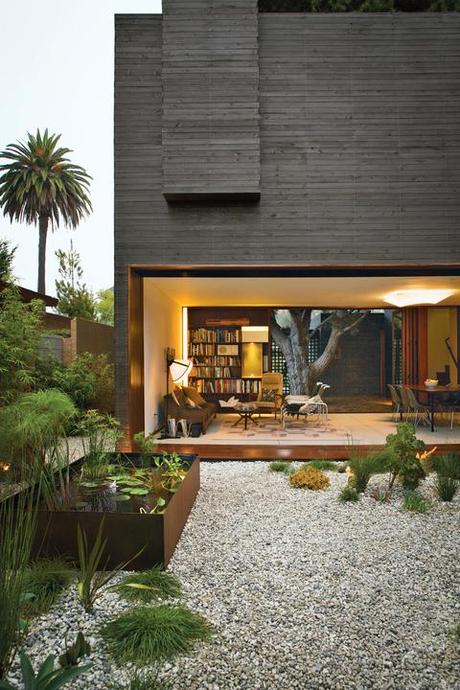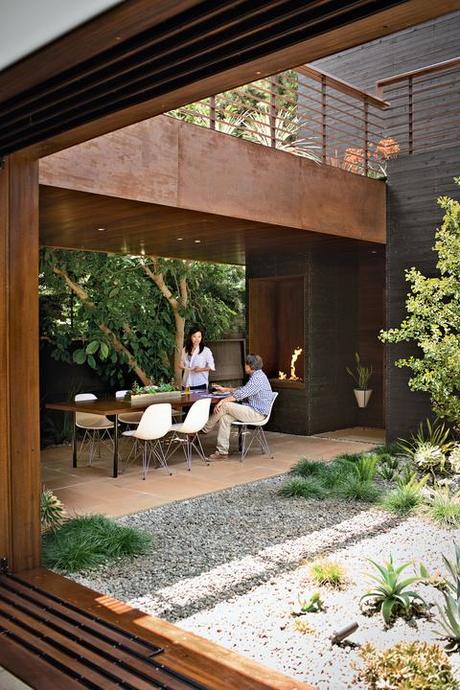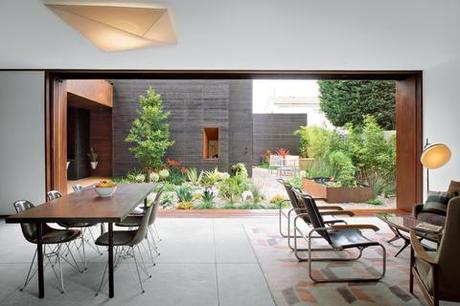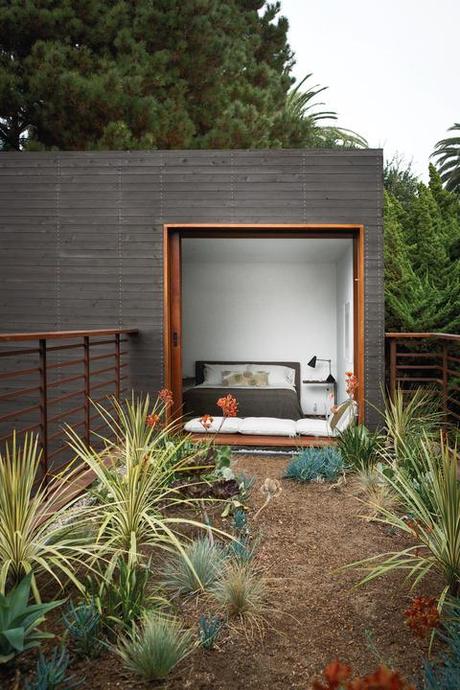
Architectural designer Sebastian Mariscal and project manager Jeff Svitak created a house in Venice, California, for Michael and Tamami Sylvester. Known as Dwell Home Venice for its role as an exemplification of modern architecture, the house is an homage to indoor-outdoor living. Photo by Coral von Zumwalt.
It was a love for architectural diversity that first drew Michael Sylvester to Venice, California, known for its tiny 1920s bungalows set cheek by jowl with lot-hogging postmodern boxes. He bought a 5,600- square-foot piece of land with one of those bungalows on it, “only it wasn’t a cute Craftsman with redeeming values; it was a stucco box with structural problems,” says Sylvester. He and his wife, Tamami, lived in the bungalow and eventually called upon Boston-based architectural designer Sebastian Mariscal—whose Wabi house (see Dwell, September 2011) particularly intrigued Sylvester—and allowed him free rein on a design for a new house. As he is known to do, Mariscal took an organic approach. “When I first visited the site, I was moved by how the trees in the front were creating a special silence of green within the eclectic neighborhood of Venice,” says Mariscal. “The first thing that came to my mind was that I must preserve the same view, meaning my design cannot be seen from the street—only trees, only green.” The process of creating the house—built as a living design laboratory to be known as Dwell Home Venice—has been well documented by Sylvester, who tells the story of its journey.
Michael Sylvester: Sebastian had an immediate reaction to the trees on the site. There were several mature trees: a 40-foot-high pine tree, a California live oak, and a magnolia. So Sebastian immediately said—actually announced—that he was going to keep all the trees on the site as part of the program. I loved this idea, but thought it looked a real challenge because several of them were on the most buildable parts of the land. So it was interesting to me that he would set such an obstacle for himself. He also said that he wanted to put the garage on the rear alley, essentially to hide the front of the house behind vegetation.
Slideshow
The couple often dines on the patio off the kitchen, warmed by a fireplace from Spark Modern Fires. Photo by Coral von Zumwalt.
One driving idea here is that every interior room of the house has a corresponding outside space. Each has its own deck, patio, roof garden, or courtyard. We call these outdoor rooms; it’s not a house with a yard. All of Sebastian’s rooms are very intimately scaled, but the rooms feel huge because they open onto outdoor rooms. In the design phase I was pushing Sebastian to enlarge some of the rooms. He disagreed, and now that the house is finished and we’re experiencing the spaces, I understand why. In a modern home, making a space larger is a design cop-out. It’s an easy way to say, Oh look, this room is modern because it has a high ceiling. Anyone can do that, but working out how to keep a room more intimately scaled and yet not feel cramped, that takes more talent. Slideshow
In the main living area, designer Delta Wright of Curated paired vintage finds with the owners’ existing furniture. The lighting, including the Ukiyo G ceiling light by Manuel Vivian for Axo Light, is from Lumens. Photo by Coral von Zumwalt.
We were not just trying to integrate every room with the outdoors; another idea was driven by a very specific part of the brief I had for Sebastian. My family and Tamami’s family do not live in the USA. Our family members live in Tokyo, Sydney, Hong Kong, and Auckland; if they come to visit, they don’t stay for a weekend, they stay for a month or two. So we wanted to have this idea that you can be in your own private space, integrated with nature, and you don’t know that someone else is in a room next to you or around the corner. So you can have a group of people that are all close to each other, but they all have privacy. That’s what we were seeking and one of the reasons it’s broken up into modules. It’s just a collection of spaces, like you would find in a compound.Sebastian designs with light as much as he designs with mass. You can see that in the house; there are lots of subtle ways in which corners or walls cast a shadow onto a space beautifully. There’s a unique consciousness of designing with natural light. The celosía, the wooden screen out front, is just one example—the way it casts shadows at different times of the day. There are lots of aha moments as you walk through the house.
Slideshow
A guest bedroom, with furniture from Room & Board, overlooks the bridge above the dining courtyard. The home’s landscape architecture is by Ventura, California–based Jack Kiesel. Photo by Coral von Zumwalt.
I don’t think any of what we keep discovering as we live here is by accident. This is all part of Sebastian’s design vision. Sebastian is an auteur. That’s reflected at all scales, from the whole scale of the property down to minute details: the cabinetry, the joinery, small windows onto gardens. Things we take delight in discovering were all part of his vision from the beginning. I think this is a testament to the scope of his talent.Make It Yours
Stain It Black
The knotty cedar cladding from Crenshaw Lumber was pretreated with an ebony stain from Timber Pro UV—twice on both sides—prior to being brought to the site, where it was left for eight weeks so that it could adjust to the moist seaside air before installation. “Cedar siding swells or shrinks when it gains or loses moisture while it reaches equilibrium with the content of the surrounding air,” says Michael. On the Wabi House in San Diego, Mariscal used a charred cedar, but staining gives the same effect for a lower cost. crenshawlumber.com timberprocoatings.com
Mix It Up
The couple chose to contrast the wood in the master bath with a smooth Caesarstone counter in Organic White 4600, which was measured and cut specifically for the space. They added a bit of shine with polished-nickel Upton fixtures from Toto. caesarstoneus.com toto.com
Heavy Metal
For the seating area in the main interior courtyard, the designer found Inox chairs by Brazilian designer Zanini de Zanine at Thomas Hayes Gallery in Hollywood. Made from polished stainless-steel sheets sal-vaged after Brazilian coins were cut out from them, the chairs are very sturdy. thomashayesgallery.com
Vessel Mania
Michael and Tamami brought greenery to the master bath courtyard, which is lined with Eco Arbor Designs deck tiles, in the form of succulents in a ceramic Peanut planter by John Follis for Arch- itectural Pottery from Vessel. ecoarbordesigns.com architecturalpottery.com
The Doors
Throughout the house, floor-to-ceiling mahogany-frame doors from Archispec “blur the border between indoor and outdoor,” says Tamami. In the main living area, five doors slide into a pocket, creating a nearly 23-foot-wide opening on one side. Another set on the opposite side allows the breezes to blow straight through the house. All of the windows in the house, including the one in the den are also from the manufacturer. Just to the right of the den is the celosía screen, which allows a peek into the pine needle courtyard. archispecllc.com
